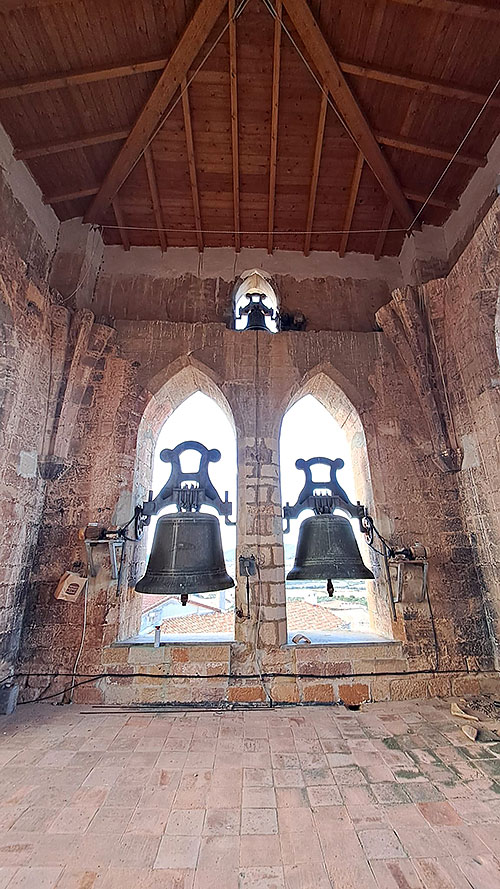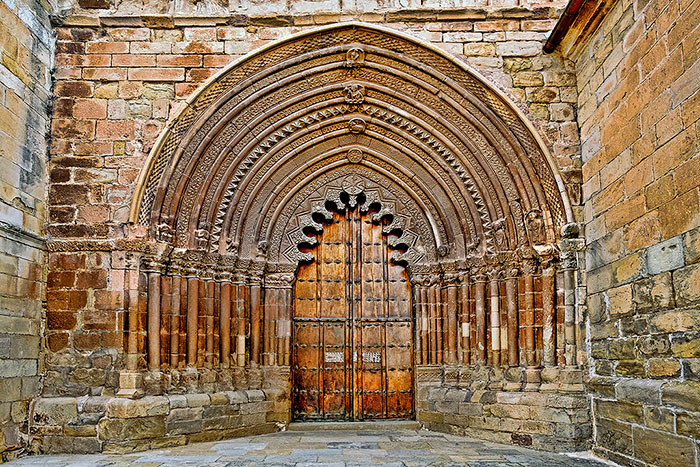August 29th
To the sound of bells. A religious, cultural and social reading of the parish of San Román de Cirauqui.
Román Felones Morrás
Parish Church of San Román, Cirauqui
March 2, 2024 marked the one hundredth anniversary of an event of great religious and social impact on the life of Cirauqui: the blessing of five new bells for the parishes of San Román and Santa Catalina. Nothing more timely, therefore, than to announce the lecture planned in the Heritage cycle with a general ringing of the bells of the parish of San Roman, one of which, the largest, was celebrating its centenary.
The first part of the lecture was dedicated to present the historical data about the bells of San Román in the XIX and XX centuries, taken from the file Municipal de Cirauqui (AMC), the parish file and the regional press. It began with a brief gloss on the importance of bells in the life of a town, underlining their character as a basic element of any religious building, the casting materials and the most usual inscriptions on them. Its liturgical and horary functions were listed, linked to the festive, the funeral, the conjuration of clouds and plagues, the summons to councils and auctions, or the calls to bounce in case of fires or serious matters, pondering its material and artistic value, in addition to the cultural, as guardians of the secret of the daily life of our ancestors who lived attentive to their sounds, organizing their days in the ordinary and in the extraordinary.

View of the bells of San Román de Cirauqui from inside the tower. The largest, located on the left, is the one blessed on March 2, 1924.
These bells were governed by three basic tolls: the swinging (oscillating movement of the bell that makes the clapper move to the same rhythm striking the instrument and producing a binary sound), the turning (complete rotation of the bell, with a yoke that has counterweights of lead or other material to facilitate the movement, which produces a tertiary sound) and the peal guide (in which the bell is fixed and is rung manually through the movement of the clapper with a rope). Finally, every bell was subject to an act of blessing, a long ceremony that included a psalmody, incensation, anointing with holy oils, holy water and salt, as if it were a baptism. The bell was usually given a specific name, usually suggested by its godfather or sponsor.
After this general introduction, we went on to offer the historical data collected by Xabier Azanza in a article about the bells of Cirauqui in the 19th century. In them reference letter is made to the solemn ceremony of blessing of the main bell, with data of the date, attendance of the chapter, weight and master bell ringer in charge of the casting and placement in the tower. The first bell was blessed in 1815 and was placed on the right side. This same bell, which always ranged between 1,000 and 1,200 kilos, was cast again in 1843, 1858 and 1877. Next to this one there are references to two other bells, the one located on the left side, blessed in 1818 and weighing somewhat less, and a small bell blessed in 1843.
Entering the twentieth century, the global renovation of the bells took place in 1924. On March 2, the file Municipal records in the book of conference proceedings the agreement of plenary session of the Executive Council which reads as follows:
To accept the invitation made by the Parish Priest Mr. Francisco Velasco and of course to become sponsors of the five bells that are going to be placed in the towers of the two churches; that the Corporation attends all the religious acts that are celebrated; that the music band is ordered to liven up the acts, that some dozens of rockets are fired and that pastries, rancid wine and sweets are bought to celebrate the celebration.
The event was reported in the Diario de Navarra of March 4, 1924. In a rhetorical and high-flown language, the correspondent gives an account of the event and points out that
Five bells were blessed in Cirauqui for its church. Cast in the workshops of Vidal Erice, from Pamplona, they weighed 1200, 450, 140, 80 and 60 kilos respectively. At four o'clock in the afternoon, at the invitation of the parish priest Francisco Velasco, the town council and authorities gathered at the town hall and, accompanied by the music band, they went to the parish church. A procession was formed to the place where the bells were located, and the parish priest proceeded to bless them, while numerous rockets were fired. The bells were baptized, two with the name of Saint Barbara, two with the name of Corazón de Jesús and one as Saint Catalina; on the edges were inscribed the name of the City Council, as godfather, and that of the parish priest. Finally, the Blessed Sacrament was exposed and the Rosary was prayed.
But the process did not end with the placement of the bells. On July 2, 1926, the parish chapter addressed the City Council requesting an advance of 2,300 pesetas of the 10,000 pesetas loan that the City Council owed to the parish, payable in annuities of 500 pesetas, to pay the debt with Mr. Erice, who threatened to take the bells if the payment was not made. It is possible to deduce that the loan was made, because the bells continue in the parishes and there is no news of any lawsuit referred to this payment.
In the second part of the lecture a brief review of the interior of the parish, as a jewel of the heritage of Cirauqui that it is, was made. This review not only focused on its artistic aspects, but also on a religious, cultural and social reading of a building that represents the history of the town like no other. The church is the most imposing building, materially speaking, of the town throughout its history; the center and summit of the medieval hamlet, today softened with the new constructions; and the result of an effort of centuries in which all the generations of parishioners have participated until our days, sustained with the tithes and first fruits, alms and donations of the faithful, with which the works have been carried out and the factory of the church and the maintenance of its clergymen have been maintained.

General view of the front of the church, late 12th century.
The speaker made a tour of its construction periods, from the first temple of the thirteenth century, which was largely maintained until the late seventeenth century, and the great renovation undertaken in the late seventeenth century and throughout the eighteenth century, which gave it the appearance it has today, highlighting the provision of liturgical trousseau and furniture that the church retains to this day. Practically all the generations of parishioners of Cirauqui left their mark in the works undertaken with greater or lesser success in the parish. As an example of this, the changes promoted after the Second Vatican Council were reviewed, which were ill-advised in the remodeling of the presbytery and very appropriate in the interior painting of the church.

General view of the main altarpiece of the church, early 18th century.
The effort of the parishioners, seconded by the parish priests, has made the church clean, neat and in very good conditions of conservation, which cannot be said of Santa Catalina, the other church of the town, in need of a strong intervention. But the outlook is not promising. A sharp decline in the attendance to Sunday Mass and the age of the parishioners force us to appeal to all citizens. The links of the chain have functioned, with greater or lesser effort, investment and success in its artistic result , from the thirteenth century to the present day. attend Its walls have seen baptisms, first communions, marriages and funerals of almost all the residents of the town, an activity shared with the church of Santa Catalina for centuries. Its bells have rung to call to prayer, strike the hours, celebrate events, bid farewell to the dead and warn of the danger of fire or storms. The future is neither in religious nor civil institutions. The future is in our hands.
Our shared goal should be to know, disseminate and care for this heritage in order to pass it on in the best possible way to future generations. This will be our bequest.
